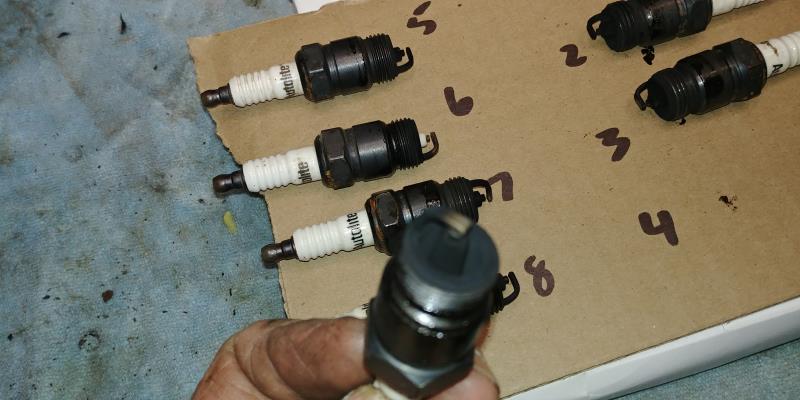Well, the Vicky drove away happy today, and, the owner made it home, still happy. Thanks everyone for all your suggestions. As I said I would, here is what I did and what I found as I went. I actually made a list of each procedure in proper order to allow me to do the most without having to work around hot manifolds. With the exception of replacing the carb with a new one, which would have been next, I think everyone's suggestion was used.
It was 90 degrees and humid when I went out in the morning.
1. The car was dead cold and started up allowed me to drive off. It was missing on at least one cylinder, but otherwise it wasn't as bad as it had been. Then the choke came off and it went bad fast. Backfiring through the carb. Lean condition.
2. I pulled it into the garage and sprayed carb cleaner around the intake and carb. No leaks detected.
3. I pulled the plugs. All but 1 was covered with dry black soot. #6 was perfectly clean. (There was the miss) The others, though black, were clean where the spark is. Plugs are Autolite 45 and are gapped at .030. These are new except a couple of test runs. They were cleaned and reinstalled.
4. Compression test: 1) 95, 2) 102, 3) 96, 4) 105, 5) 102, 6) 106, 7) 85, 8) 110. Not good, but it isn't new.
5. Vacuum started at 11" before starting the work and ended up finally at 15" @ 575 rpm. Again, not good, but better than the 8" I had when I first started working on it a month ago.
6. I carefully opened the carb and both bowls were equally full to 29/32" down from the gasket surface, which is a meaningless measurement except to tell me they are both the same.
7. Both floats were at 7/32". Ford Shop Manual says 5/32" and most Carter and Edelbrock manuals say 7/16". Big difference so I went a little lower than Ford said but was trying to not flood over, so it seemed reasonable.
8. The metering rods were not operating the same when you opened the little covers and revved the engine. I'd think they should modulate pretty much in unison because they are both operated by the same vacuum signal. I lightly cleaned them with a scotchbrite and noticed one had a very slight burr on the tip, like it had been dropped. (I was looking at this stuff with a lighted magnifying glass) I cleaned the burr off. The jet also was scarred up inside so I cleaned it up a little. In the end, both worked harmoniously.
9. One of the little soft plugs underneath looked like it may have been leaking so I tapped it with a punch. These are very soft, so use very little force.
10. The accelerator pump wasn't squirting and I found the new check valve (brass weight) from the kit wasn't allowing it. I went back to the original and it worked.
11. I went through every hole, vent or whatever I could find with welding tip cleaners, carb cleaner and compressed air. I was careful not to scratch anything or change the opening sizes.
12. New plug wire were installed. 7mm spiral silicone.
12. I put it all back together and it started and ran great. I had a little response from the mixture screws, but very little. The engine would die if I screwed them in, but it was a slow death. Holley's die fast and the turning mixture screws gives a very fast and obvious response, maybe Carters just don't?
I talked to the owner and he said it ran better than ever and his wife who was following him said it doesn't smoke anymore. I wish the mixture screws would have been more responsive, but I guess its working.
Thanks everyone one for your help!



Life isn't about arriving at the end in a pristine, well preserved body; It's about sliding in sideways, all clapped out, yelling "What a ride!"